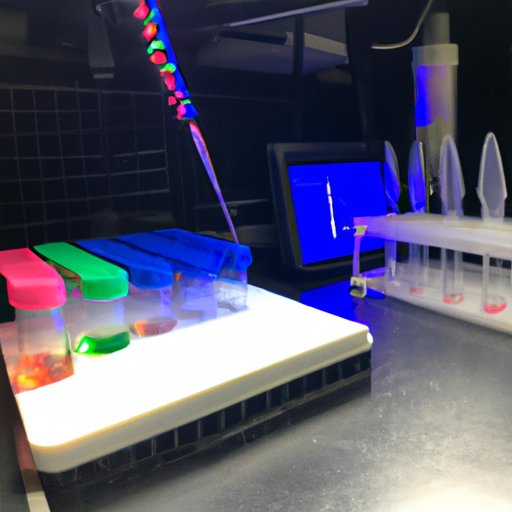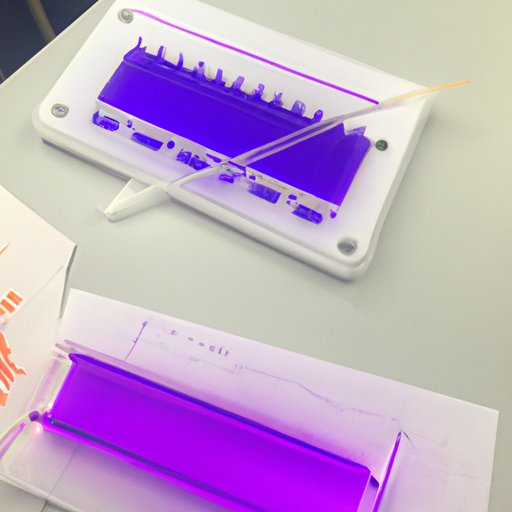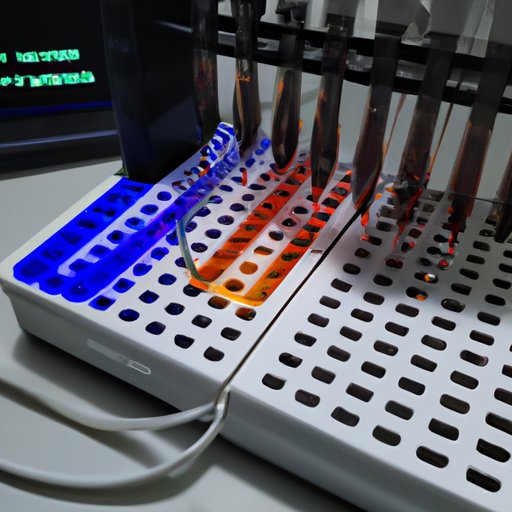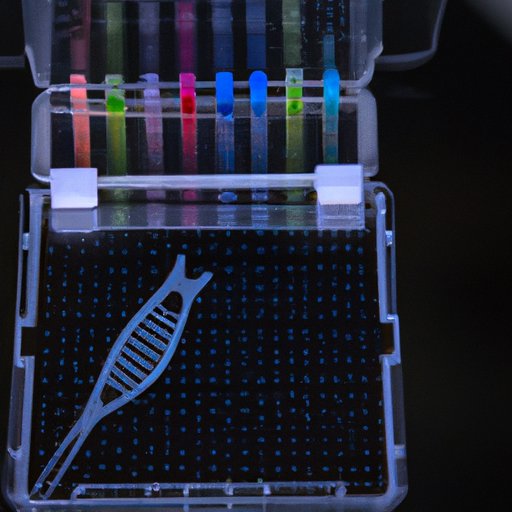Introduction
Electrophoresis is a laboratory technique used to separate particles according to their electrical charge. It is widely used in biochemistry, genetics, and other scientific fields for a variety of purposes, such as analyzing DNA and proteins or separating cells. In this article, we will provide a comprehensive overview of electrophoresis, including a step-by-step guide to setting up and running the process, an overview of the science behind it, a look at the different types of electrophoresis, how it is used in research laboratories, common applications, and troubleshooting tips.
A Step-by-Step Guide to Electrophoresis
The first step in setting up an electrophoresis experiment is to prepare the gel. The gel is typically made from agarose, a polysaccharide derived from seaweed, which forms a matrix that can be used to separate molecules based on size. Once the gel is prepared, it’s time to prepare the samples. Depending on the type of electrophoresis being performed, the samples may need to be treated with chemicals to make them more suitable for the process. Once the samples are ready, they can be loaded onto the gel and the electrophoresis process can begin.
The next step is to set up the electrophoresis apparatus. This typically involves connecting the electrodes to the power source and ensuring that all the components are properly connected. Once the apparatus is set up, the power can be turned on and the electrophoresis process can begin. During the process, electric current is applied, causing the particles in the sample to move through the gel in response to the electrical field.
As the particles move through the gel, they become separated according to their charge and size. Smaller particles will move faster than larger particles, allowing for separation of the sample into distinct bands. Once the process is complete, the gel can be removed from the apparatus and the separated particles can be visualized using a variety of techniques, such as staining or fluorescent labeling.

An Overview of the Science Behind Electrophoresis
To understand how electrophoresis works, it’s important to have a basic understanding of the physics and chemistry behind the process. At its core, electrophoresis is a process that uses electricity to move particles through a medium. The electric field causes the particles to move in response to the force of the field, resulting in the separation of the sample.
From a physics perspective, the movement of particles in an electric field is governed by the principles of electrostatics. As the particles move through the medium, they experience forces due to the electric field and the drag of the medium itself. These forces cause the particles to move in response to the electric field, resulting in the separation of the sample.
From a chemistry perspective, the particles in the sample are attracted to or repelled by the electric field depending on their charge. Positively charged particles are repelled by the electric field, while negatively charged particles are attracted to it. This leads to the separation of the sample into distinct bands according to their charge.

Exploring the Different Types of Electrophoresis
There are several different types of electrophoresis, each of which is suited for a particular purpose. Agarose gel electrophoresis is the most commonly used type of electrophoresis, and is used for a wide range of applications, such as DNA analysis or protein analysis. Capillary electrophoresis is a newer technique that is often used for high throughput sample analysis, as it can process large numbers of samples quickly and efficiently.
SDS-PAGE (sodium dodecyl sulfate-polyacrylamide gel electrophoresis) is another type of electrophoresis that is used to separate proteins according to their size. This technique involves the use of detergents to solubilize the proteins, allowing them to be separated more easily. This technique is often used in research laboratories to study protein structure and function.
How Electrophoresis is Used in Research Laboratories
Electrophoresis is an essential tool in many research laboratories. It can be used for a variety of purposes, such as DNA analysis, protein analysis, and cell separation. DNA analysis involves the separation of DNA fragments according to their size, while protein analysis involves the separation of proteins according to their size and charge. Cell separation involves the separation of cells according to their size and surface properties.
In addition, electrophoresis can be used to detect the presence of certain molecules in a sample, such as viruses or bacteria. This can be useful in diagnosing diseases or identifying contaminants in food or water.
Common Applications of Electrophoresis
Electrophoresis has a wide range of applications in both research and clinical settings. In the clinical setting, electrophoresis is often used for diagnostic tests, such as testing for genetic disorders or determining the blood type of a patient. It is also used in forensic testing, such as analyzing fingerprints or determining the identity of a suspect.
In environmental testing, electrophoresis is used to identify and quantify contaminants in water or soil samples. It can also be used to monitor industrial processes, such as the production of pharmaceuticals or the treatment of wastewater.

Troubleshooting Common Issues with Electrophoresis
Despite its many advantages, electrophoresis can sometimes fail due to a variety of issues. One of the most common problems is gels failing to run properly. This can be caused by inadequate mixing of the gel, improper loading of the samples, or incorrect power settings. Poor resolution of the samples can also be a problem, which can be caused by incorrect buffer concentrations or inadequate sample preparation.
Contaminated samples can also lead to poor results, as contaminants can interfere with the electrophoresis process. To avoid contamination, it is important to ensure that all equipment and reagents are clean and free of contaminants before beginning the experiment.
Conclusion
Electrophoresis is an essential laboratory technique used for a variety of purposes, such as DNA analysis, protein analysis, and cell separation. In this article, we provided a comprehensive overview of electrophoresis, including a step-by-step guide to setting up and running the process, an overview of the science behind it, a look at the different types of electrophoresis, how it is used in research laboratories, common applications, and troubleshooting tips.
(Note: Is this article not meeting your expectations? Do you have knowledge or insights to share? Unlock new opportunities and expand your reach by joining our authors team. Click Registration to join us and share your expertise with our readers.)
